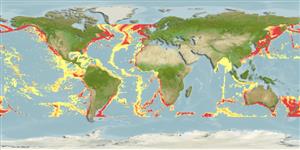>
Notacanthiformes (Halosaurs and deep-sea spiny eels) >
Notacanthidae (Deep-sea spiny eels)
Etymology: Notacanthus: Greek, noton = back + Greek, akantha = thorn (Ref. 45335).
More on author: Bloch.
Environment: milieu / climate zone / depth range / distribution range
Ecologia
marino benthopelagico; distribuzione batimetrica 125 - 3285 m (Ref. 58426), usually 128 - 1000 m (Ref. 117245). Deep-water; 61°N - 50°S, 180°W - 180°E
Worldwide except in tropical waters (Ref. 27363). North Atlantic: Gulf of Mexico and Cape Blanc, Mauritania north to Davis Strait, Canada and Iceland. South Atlantic: off South Africa. Southeast Pacific: off Chile. Eastern Indian Ocean: Australia (Ref. 7300). Southwest Pacific: New Zealand (Ref. 5755).
Size / Peso / Age
Maturity: Lm ? range ? - ? cm
Max length : 120 cm TL maschio/sesso non determinato; (Ref. 4449)
Spine dorsali (totale): 5 - 12; Raggi dorsali molli (totale): 2; Spine anali 14-17; Raggi anali molli: 125 - 145; Vertebre: 225 - 239. Presence of palatine and dentary teeth in two or more rows. Numerous dorsal spines. Small specimens are pale tan or pale bluish gray, large specimens are dark brown (Ref. 37108).
Benthopelagic (Ref. 58302) and epibenthic (Ref. 58426). Not uncommon in depths around 180 m off Iceland and Greenland. Individuals with nearly ripe eggs have been found in late autumn off Iceland. Mostly found at depths well below 200 m, but enters slightly shallower water on Grand Banks in Canada (Ref. 7251). Feeds primarily on sea anemones (Ref. 4449).
Life cycle and mating behavior
Maturità | Riproduzione | Deposizione | Uova | Fecundity | Larve
Sulak, K.J., 1990. Notacanthidae. p. 133-135. In J.C. Quero, J.C. Hureau, C. Karrer, A. Post and L. Saldanha (eds.) Check-list of the fishes of the eastern tropical Atlantic (CLOFETA). JNICT, Lisbon; SEI, Paris; and UNESCO, Paris. Vol. 1. (Ref. 4449)
IUCN Red List Status (Ref. 130435)
Threat to humans
Harmless
Human uses
Pesca: di nessun interesse
Informazioni ulteriori
Nomi ComuniSinonimiMetabolismoPredatoriEcotossicologiaRiproduzioneMaturitàDeposizioneSpawning aggregationFecundityUovaEgg development
BibliografiaAcquacolturaProfilo di acquacolturaVarietàGeneticaElectrophoresesEreditarietàMalattieElaborazioneNutrientsMass conversion
Strumenti
Special reports
Download XML
Fonti Internet
Estimates based on models
Preferred temperature (Ref.
123201): 1 - 14.9, mean 6.1 °C (based on 2531 cells).
Phylogenetic diversity index (Ref.
82804): PD
50 = 0.5161 [Uniqueness, from 0.5 = low to 2.0 = high].
Bayesian length-weight: a=0.00191 (0.00103 - 0.00352), b=3.07 (2.90 - 3.24), in cm total length, based on LWR estimates for this species & (Sub)family-body (Ref.
93245).
Trophic level (Ref.
69278): 3.5 ±0.37 se; based on food items.
Generation time: 27.5 ( na - na) years. Estimated as median ln(3)/K based on 2
growth studies.
Resilienza (Ref.
120179): Basso, tempo minimo di raddoppiamento della popolazione 4.5 - 14 anni (Assuming tmax>10).
Fishing Vulnerability (Ref.
59153): High to very high vulnerability (69 of 100).
Nutrients (Ref.
124155): Calcium = 9.83 [5.11, 21.37] mg/100g; Iron = 0.259 [0.129, 0.528] mg/100g; Protein = 16.1 [14.9, 17.3] %; Omega3 = 0.274 [0.129, 0.578] g/100g; Selenium = 39.1 [14.6, 106.8] μg/100g; VitaminA = 9.64 [1.93, 48.64] μg/100g; Zinc = 0.376 [0.235, 0.610] mg/100g (wet weight);
